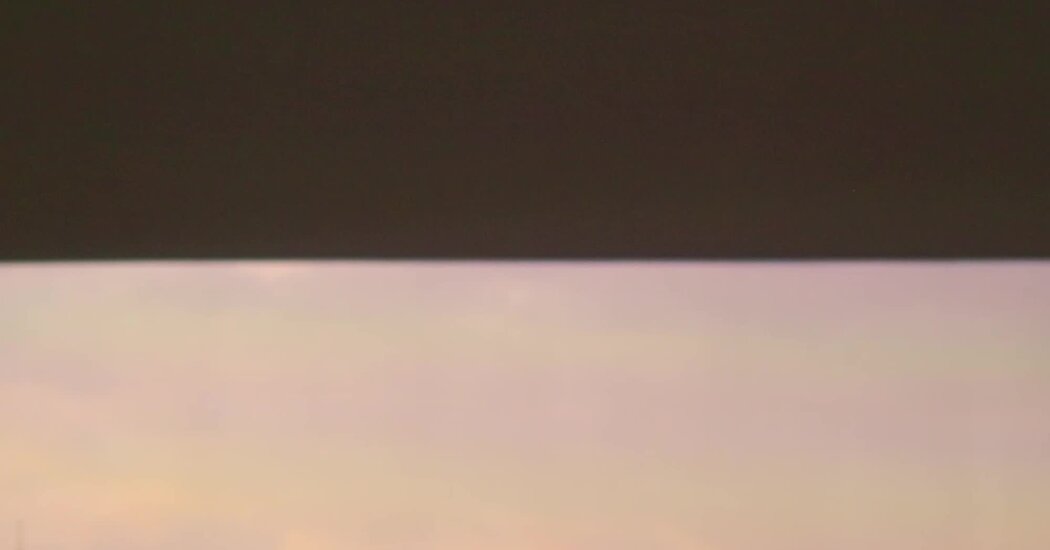Stay in your lane, or merge? “I will not go to Venice,” Claude Monet liked to promise. His dealer had always urged him to try it, saying the paintings would sell back in Paris. But at 68 the most famous painter in France was sticking shrewdly to his territory, a triangle of Normandy stretching down through Rouen to the ornamental water garden he kept northwest of Paris.
When his wife, Alice Hoschedé, insisted her husband forget his trials with “endless water lilies” and accept an invitation to stay free of charge in the floating city, Monet agreed, on an off-duty sort of basis.
They arrived on Oct. 1, 1908, and hired gondolas down the Grand Canal. “I’m too old to paint such beautiful things,” he assured her. They admired the Tintorettos at the Scuola Grande di San Rocco. They cupped handfuls of birdseed for the pigeons at Saint Mark’s Basilica. Someone snapped a picture of them there, Claude and Alice, arms outstretched and covered in birds. The couple have that look of tourist obligation, dutiful, a little silly, tired. A bird perches on Monet’s cap.
Then the dam broke. By Oct. 9 he was putting in 10-hour days on the water in two-hour shifts, shivering at the easel until December, resulting in 37 paintings. What changed?
If you judge by the 19 paintings the Brooklyn Museum has reunited for the lush and greedy “Monet and Venice,” the largest survey of this detour in Monet’s late career since Galerie Bernheim-Jeune’s “Venise” exhibition scattered these works to collectors in 1912, you’ll see that what grabbed him were the special density of the light there and the dreamlike supremacy of water. How could they not?
But it is the real contribution of this ambitious show, and also its liability, to imagine the less obvious challenges that must have faced Monet, by arraying 70 other works by different artists of his time and before him. These challenges, to do with recognition and art history, cut to the heart of his craft and emboldened him, the curators argue, to play with water and solids in a way that would make his later, more iconic water lilies so successful.
The icon here is the Doge’s Palace. In life it’s a broad rectangle of marble atop a colonnade. It’s imposing but also oddly see-through, thanks to its alternating pink and white stonework, like a bar of lathered soap standing on tippy toes.
Monet would begin his day across the water from it at 8 a.m. Three views are here, and what you notice is how dutifully the building has been rendered. Even through his fluffy brushwork and his off-kilter distances, the rectangle is pocked with seven perky Gothic windows, the two rightmost ones drooped to depict the renovations after a fire in 1483.
When painting something famous, Monet might zoom in or swaddle it in the woozy atmospheric effect he called the “enveloppe,” to draw our attention to the act of seeing through space. He did this with the Houses of Parliament in London, a canvas of which, from 1903, is on view, depicting a flat violet silhouette of the building’s spires merging into the River Thames, more landmass than landmark. It is one of 15 non-Venetian Monets here.
In Venice, Monet seems more cowed into representation. In the five views of San Giorgio Maggiore, the domed cathedral that dominates the Grand Canal and which Monet would paint from 10 a.m. until lunch, he broadcasts specific pediments and column bays through his soups of periwinkle, emerald, buttercream and rose. Whether you’ve seen these buildings in person or just books, you are drawn into the game of “Is this true to life?”
Unlike a haystack in a field, Venice brought with it the burden of representation reaching back through modern art history. In that spirit the curators, Lisa Small of the Brooklyn Museum, and Melissa Buron of the Victoria and Albert Museum in London, sample Venice from the 18th century, starting with a wall of 30 etchings of the city by Michele Marieschi, and a lovely large “vedute,” or city vista, by Canaletto.
Both Venetians primed the market for tourists. Accepting their invitation from Victorian London was J.M.W. Turner. Six of his watercolors are here, effervescent and quick. So is an exacting architectural watercolor from John Ruskin, Venice’s preservationist scold.
Then come the moderns. Signac with a parti-colored lagoon, Sargent with six watercolors, Whistler with moody streetscape etchings, the early art photographers Steichen and Coburn.
It’s a lot, and not all immediately relevant to Monet. The goal seems to be a sense of how omnipresent the city must have been in the mind of a newcomer, how daunting the prospect of failure. (For viewers who may have never braved the expense and crowds of Venice, the show offers some immersive bait: In the foyer is a six-channel video collage of the city waking up at sunrise turning various alleys from blue to yellow. It’s tasteful, but if this kind of thing irks you, move on to the paintings.)
“It’s frightening the number of painters here, in this small square on San Giorgio,” Alice wrote to her daughter. The American artist Louis Ashton Knight had to lend the shivering Monet his coat, so late had the Frenchman postponed his departure.
Did they swap notes? Plein-air realists like Knight (not on view here) tended to segregate ground from water with their different kinds of brushstrokes. They seem to be intuiting what scientists have only recently found: that we perceive solids and liquids in different parts of the brain. But Monet saw things differently. He wanted to capture perception before the brain has time to digest different kinds of matter. And Venice with its bobbing facades gave Monet some powerful ammunition.
The sharp yellow scoops down in the fore-water of a Ducal Palace and the bruise-colored mudslide of his “Rio della Salute” present the physical world as if space and time have divorced.
Apparently every other painter wants the masts and the sails or the intoxicating night lights in their canvases. Not Monet, who scrubbed his Venice of all humanity. Easier said than done. His visit coincided with the annual Presentation of the Virgin. “A ship is almost every day anchored precisely in front of the motif that I wanted to paint,” he complained. Alice saw him circle a scene in his gondola for hours, “absolutely furious and regretful,” Alice wrote.
In Brooklyn, this post-human vibe can exhilarate. When Monet spills a slice of dock into the foreground of his vibrating Ducal Palace, he seems to be standing you, the last human alive, where he once was, to witness this abandoned Floating City. Elsewhere he’s too sugary, as with two rainbow sunset views of San Giorgio Maggiore. Only his successors — like the philosopher Derek Parfit in his photo-pilgrimages, or the filmmaker Nicholas Roeg in certain scenes of “Don’t Look Now” — would really capture the isolating beauty of a Venice unobserved.
Back in Giverny, after Alice died of leukemia in 1911, Monet returned to the Venice pictures, finishing 29. Revisiting them, he thought only of Alice, he said. He may have used her picture postcards, on view in the show’s many vitrines of ephemera, to prompt his memory. But the spell had broken. When the paintings went up at Bernheim-Jeune in 1912, to critical praise, he confided to his longtime dealer Paul Durand-Ruel, “They are bad and I’m certain of it.”
We know better, and the curators go so far as to suggest that Venice “replenished the immersive vision he was developing” for the lilies on which he had stalled.
For this, the show makes much of a line to Durand-Ruel, who was about to debut those flowers in 1909: “My trip to Venice has had the advantage of making me see my canvases with a better eye.”
This “better eye,” according to three lily paintings in Brooklyn, might have had something to do with the confusions of subject and reflection Monet refined so well in aquatic Venice. But keep in mind that he said this during damage control with Durand-Ruel. His loyal dealer of 38 years was deeply hurt that Monet had already chosen a hipper, Futurist-friendly gallery for “Venise.” Times were changing, and Monet was playing both sides.
So is the Brooklyn Museum, which wants to close the show with a bang. In an ellipse-shaped gallery, modeled after the l’Orangerie in Paris, which houses Monet’s later colossal lilies, 10 stately Venice canvases surround you on curvilinear walls, unlabeled. Just paint. Which is lovely. The walls, however, are colored in overwhelming lapis-lazuli.
For such a pigment-purist show, with quiet gradations on loan from far and wide, this is might bug you. It turns Monet’s greens a little more indigo, his oranges nearly purple. His latent blues scream. (On top of this, speakers pipe in a Vivaldi-esque orchestral composition by Niles Luther — the Brooklyn’s inaugural composer in residence — for this show.) I found it a little too much Béarnaise on the steak. Come for yourself, though, sample this terrific buffet of salutations from the great man’s last trip, and be your own judge.
Monet and Venice
Through Feb. 1 at the Brooklyn Museum, 200 Eastern Parkway, Brooklyn; (718) 638-5000; brooklynmuseum.org.
The post Monet Was Reluctant. Venice Seduced Him. appeared first on New York Times.




